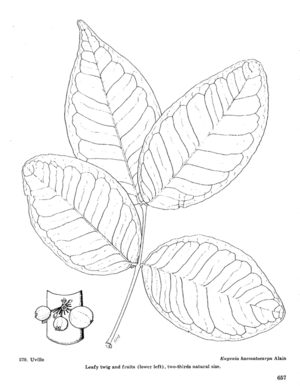Eugenia haematocarpa facts for kids
Quick facts for kids Eugenia haematocarpa |
|
|---|---|
 |
|
| Conservation status | |
| Scientific classification | |
| Genus: |
Eugenia
|
| Species: |
haematocarpa
|
Eugenia haematocarpa, also known as uvillo or Luquillo Mountain stopper, is a very rare plant found only in Puerto Rico. It's a type of tree that belongs to the Myrtaceae family, which also includes plants like eucalyptus and guava. This special tree is considered an endangered species by the U.S. Fish and Wildlife Service, meaning it's at high risk of disappearing forever. Because it's so rare, there's a plan in place to help it recover and grow stronger.
Contents
Meet the Luquillo Mountain Stopper
This unique tree was first discovered and collected in 1939 in an area called Naguabo. Scientists have since found it growing in two main places on the eastern side of Puerto Rico: the Caribbean National Forest and the Sierra de Cayey mountains.
Where Does It Live?
The Luquillo Mountain stopper prefers to live in mountain forests. It often grows alongside other trees like Syzygium jambos, Prestoea montana, Tabebuia heterophylla, Ocotea leucoxylon, Inga laurina, and Alchornea latifolia. These trees create a special environment that Eugenia haematocarpa needs to survive.
What Does It Look Like?
This is an evergreen tree, which means it keeps its leaves all year round. It can grow up to 6 meters (about 20 feet) tall.
- Bark: The bark is gray or whitish and peels off in plates, like old paint.
- Leaves: Its leaves are tough and oval-shaped, growing up to 18 centimeters (about 7 inches) long. They usually grow in pairs.
- Flowers: The flowers grow in clusters right on the tree's trunk. Each flower has four pink petals, a little over 2 centimeters (less than an inch) long.
- Fruit: The tree produces a dark red berry. These berries are usually between 2 and 3 centimeters (about 1 inch) long.
Why Is It Endangered?
The main reason Eugenia haematocarpa is so rare is something called habitat destruction. This happens when the natural places where plants and animals live are damaged or destroyed. For this tree, it means its forest home is shrinking, making it harder for new trees to grow and survive. Protecting its forest habitat is key to helping this special tree thrive again.


